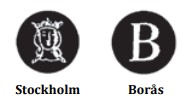Silver stamps
Many people wonder which silver hallmarks are available on the Swedish market and how to interpret them.
In this article we will try to lift the veil surrounding Swedish silver hallmarks.
Here are examples of how silverware can be stamped:
 or like this
or like this ![]()
The first four stamps, the cat's foot, the silver stamp (S) and the year stamp (G11) are no longer mandatory and have been replaced by the Responsibility Stamp (J) and the fineness stamp (830) which describe who manufactured the product and how much silver the material contains. These stamps are registered and regulated by law.
Below we present a compilation from SP, the Swedish Testing and Research Institute, which provides a detailed explanation of stamps.
A hallmark on a piece of jewelry guarantees that the item has been approved after an impartial check of the amount of precious metal, i.e. a determination of the fineness.
THE SWEDISH CONTROL STAMP - THE CAT'S FOOT

The Swedish hallmark, the well-known Kattfoten, consists of the small national coat of arms Tre Kronor placed in a trepass-shaped ("three-arched") shield. Hallmarks differ depending on the precious metal - for gold it is Kattfoten, for silver Kattfoten with a following S in a hexagonal shield and for platinum Kattfoten with a following P in a hexagonal shield.
The cat's foot was first introduced in 1754 and is available in two versions: The trefoil-shaped cat's foot for Swedish-made objects, and the so-called oval for imported objects. As of July 1, 1988, we only use the trefoil-shaped cat's foot for both Swedish-made and imported objects. The cat's foot is a guarantee of authenticity. (Not mandatory - Editor's note.)
INTERNATIONAL CONTROL STAMPS - THE WEIGHT STAMP

The CCM is a common control mark for the European Precious Metals Convention:
- CCM stamp for 750/1000 gold
- CCM stamp for 925/1000 silver
- CCM stamp for 950/1000 platinum
RESPONSIBILITY STAMPS
Responsibility stamps are the stamps that the Swedish manufacturer or importer has stamped on their work. In addition to the responsibility stamps, other stamps may be present. They may be the Swedish manufacturer's design stamp or the foreign manufacturer's own stamps. These silver stamps differ in appearance from the responsibility stamps. There are many name stamps and around 6650 different letter combinations. There are also various place marks and year designations, as well as a fineness stamp that indicates in thousandths how much pure gold the object contains. All of these stamps are collectively called responsibility stamps.
The four responsibility stamps are:
- Fineness stamp - Mandatory
- Name stamp - Voluntary
- Placemark - Voluntary
- Year designation - Voluntary
FINENESS STAMP

The fineness mark indicates the amount of precious metal in a piece of jewelry. For gold and platinum items weighing more than one gram, the fineness mark must be present, along with a Cat's Foot or name mark. For silver, there are no requirements for a fineness mark or other marks. The fineness is stated in parts per thousand, e.g. 750, which means that the jewelry consists of 75% gold. The remaining 25% consists of other metals such as silver and copper. The fineness of the gold is often stated in carats.
NAME STAMP

The name stamp consists of two or more letters in a rectangular frame, which tells which manufacturer or importer created or imported the item. The name stamp can only contain letters, so logos or other company marks cannot be registered. The letter combination is normally reserved for 20 years for the holder after deregistration and cannot therefore be re-registered by a new holder during that time. There are approximately 6,700 registered manufacturer or name stamps from 1913 to the present, of which approximately 2,200 are active today.
PLACE MARK

The locality mark is a responsibility stamp and indicates the Swedish place of manufacture or the importer's residence. It is established by the Swedish Board for Accreditation and Technical Control, SWEDAC. If a mark is missing for a location, SWEDAC can establish one upon request. The most recently established locality marks have indicated the municipality (e.g. Orust and Vårgårda).
The town mark, as it was previously called, began to be used as early as the 1490s as a complement to the manufacturer's stamp in a few places, but it was not until 1689 that it became a standard throughout the country. At that time, the mark also took on the character of a control stamp, which was only stamped on work that had been checked and approved (by the goldsmiths' guild). When the control was taken over by the state in 1754 and the Kattfoten was introduced as a control stamp, the town mark regained its original meaning as a stamp of responsibility.
From around 1860, the town emblem has consisted of only one letter indicating the city's initial letter, with only the font and frame varying for towns that begin with the same letter. Only Stockholm has retained its city coat of arms in the town emblem. Other exceptions are Gothenburg and Kristianstad with a crowned G and C respectively, as well as Karlskrona with a C in a mirror monogram.
Since 1988, the placemark can also be used by importers of precious metal products as a complement to their registered name stamp. There are currently 184 established placemarks.
YEAR NAME

The year designation indicates the year of manufacture. In Sweden, since 1754 we have had an unbroken series of year letters, (now year designations) common to the entire country. Previously, there were different year letter series for some cities (e.g. Stockholm from 1689). In 1759, all previous series were discontinued and they started from the beginning again with the letter A. When the entire alphabet (with the exception of J, W, Å, Ä and Ö) was completed in 1782, a 2nd was added behind the letters and after another 24 years a 3rd year was added.
TABLE YEAR NAME SILVER
|
1
|
2 | 3 | 4 | 5 | 6 | 7 | 8 | 9 | 10 | 11 | 12 | |
| A | 1759 | 1783 | 1807 | 1831 | 1855 | 1879 | 1903 | 1927 | 1951 | 1975 | 1999 | 2023 |
| B | 1760 | 1784 | 1808 | 1832 | 1856 | 1880 | 1904 | 1928 | 1952 | 1976 | 2000 | 2024 |
| C | 1761 | 1785 | 1809 | 1833 | 1857 | 1881 | 1905 | 1929 | 1953 | 1977 | 2001 | 2025 |
| D | 1762 | 1786 | 1810 | 1834 | 1858 | 1882 | 1906 | 1930 | 1954 | 1978 | 2002 | 2026 |
| E | 1763 | 1787 | 1811 | 1835 | 1859 | 1883 | 1907 | 1931 | 1955 | 1979 | 2003 | 2027 |
| F | 1764 | 1788 | 1812 | 1836 | 1860 | 1884 | 1908 | 1932 | 1956 | 1980 | 2004 | 2028 |
| G | 1765 | 1789 | 1813 | 1837 | 1861 | 1885 | 1909 | 1933 | 1957 | 1981 | 2005 | 2005 |
| H | 1766 | 1790 | 1814 | 1838 | 1862 | 1886 | 1910 | 1934 | 1958 | 1982 | 2006 | 2030 |
| IN | 1767 | 1791 | 1815 | 1839 | 1863 | 1887 | 1911 | 1935 | 1959 | 1983 | 2007 | 2031 |
| K | 1768 | 1792 | 1816 | 1840 | 1864 | 1888 | 1912 | 1936 | 1960 | 1984 | 2008 | 2032 |
| L | 1769 | 1793 | 1817 | 1841 | 1865 | 1889 | 1913 | 1937 | 1961 | 1985 | 2009 | 2033 |
| M | 1770 | 1794 | 1818 | 1842 | 1866 | 1890 | 1914 | 1938 | 1962 | 1986 | 2010 | 2034 |
| N | 1771 | 1795 | 1819 | 1843 | 1867 | 1891 | 1915 | 1939 | 1963 | 1987 | 2011 | 2035 |
| O | 1772 | 1796 | 1820 | 1844 | 1868 | 1892 | 1916 | 1940 | 1964 | 1988 | 2012 | 2036 |
| P | 1773 | 1797 | 1821 | 1845 | 1869 | 1893 | 1917 | 1941 | 1965 | 1989 | 2013 | 2037 |
| Q | 1774 | 1798 | 1822 | 1846 | 1870 | 1894 | 1918 | 1942 | 1966 | 1990 | 2014 | 2038 |
| R | 1775 | 1799 | 1823 | 1847 | 1871 | 1895 | 1919 | 1943 | 1967 | 1991 | 2015 | 2039 |
| S | 1776 | 1800 | 1824 | 1848 | 1872 | 1896 | 1920 | 1944 | 1968 | 1992 | 2016 | 2040 |
| T | 1777 | 1801 | 1825 | 1849 | 1873 | 1897 | 1921 | 1945 | 1969 | 1993 | 2017 | 2041 |
| U | 1778 | 1802 | 1826 | 1850 | 1874 | 1898 | 1922 | 1946 | 1970 | 1994 | 2018 | 2042 |
| V | 1779 | 1803 | 1827 | 1851 | 1875 | 1899 | 1923 | 1947 | 1971 | 1995 | 2019 | 2043 |
| X | 1780 | 1804 | 1828 | 1852 | 1876 | 1900 | 1924 | 1948 | 1972 | 1996 | 2020 | 2044 |
| Y | 1781 | 1805 | 1829 | 1853 | 1877 | 1901 | 1925 | 1949 | 1973 | 1997 | 2021 | 2045 |
| Z | 1782 | 1806 | 1830 | 1854 | 1878 | 1902 | 1926 | 1950 | 1974 | 1998 | 2022 | 2046 |
Since the name stamp can change owners over the years, the year designation serves as a good complement in identifying the manufacturer of a particular work. Since 1988, the year designation has been optional and can also be found on imported works.
Understanding silver hallmarks is an art and a science. By understanding and interpreting these marks, we can appreciate the true value of silver objects. So, the next time you come across a silver hallmark, take a closer look. You may have just found a hidden treasure.
